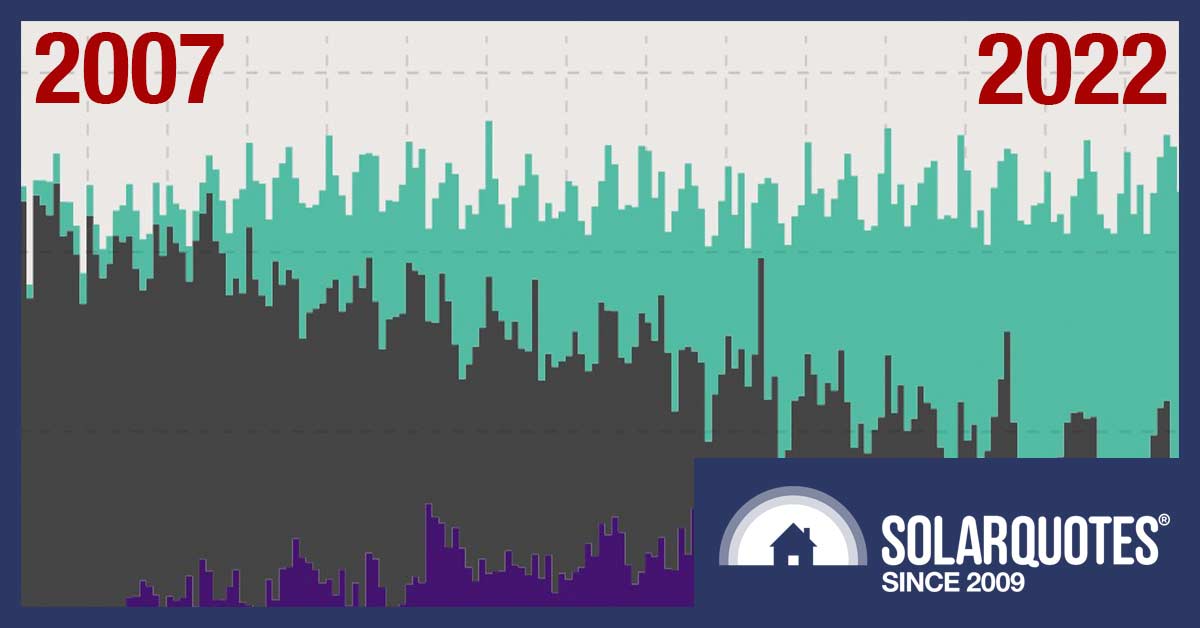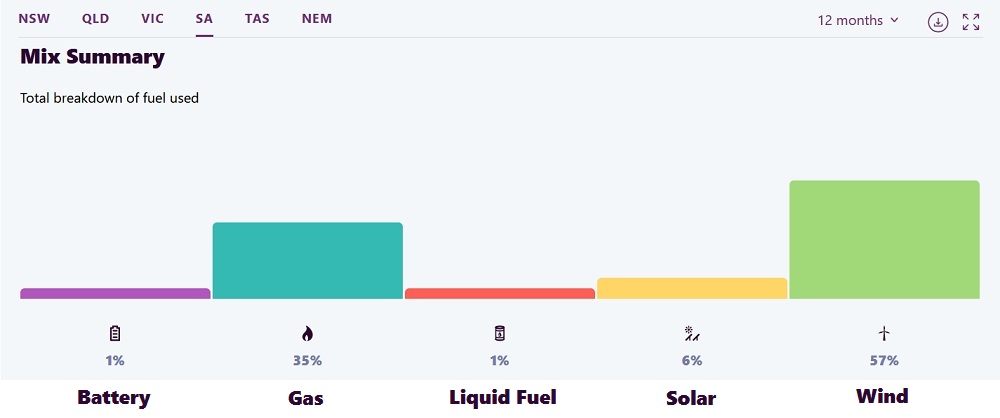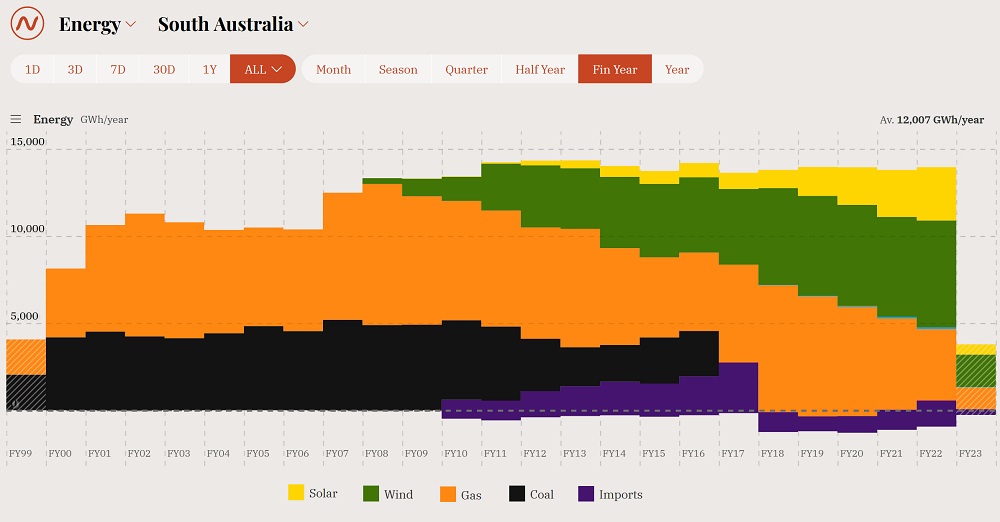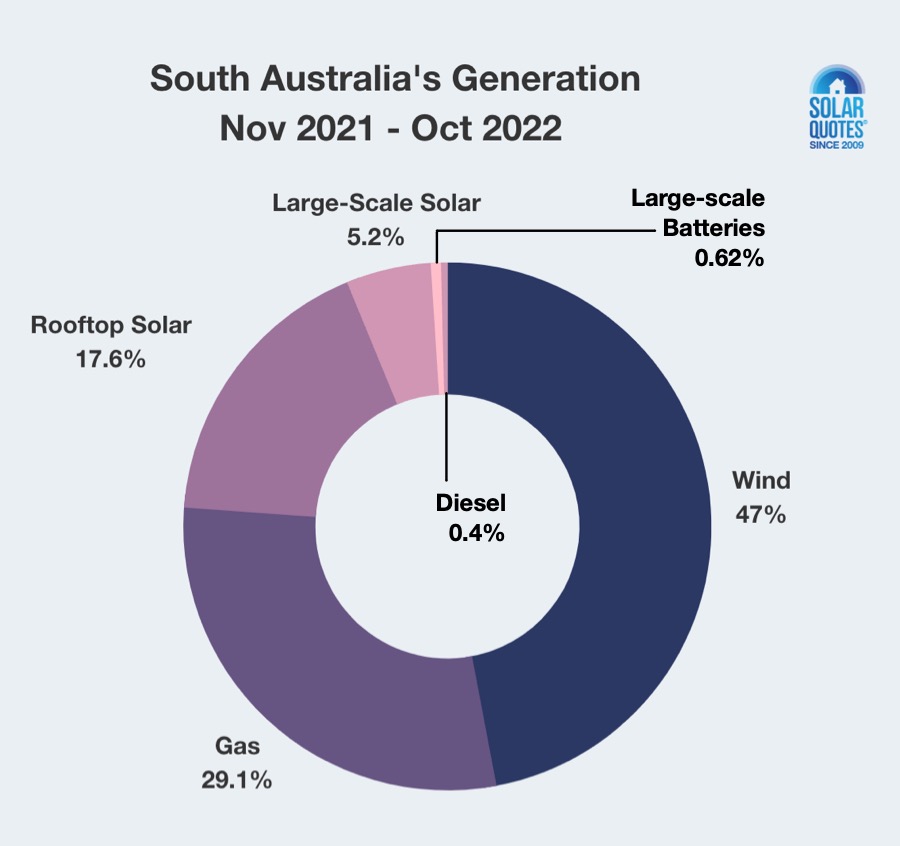
SA’s electricity generation mix: Green = Renewables, Black = Fossil, Purple = Imports.
In 2007, less than 1% of South Australia’s electricity came from renewable sources. An army of trolls claimed it was impossible for intermittent renewables to power more than 20% of SA’s grid.
Fast forward 15 years, and over 12 months, wind and solar power generated 70% of SA’s electricity while the percentage of consumption that was renewable was around 64%1.
South Australia is a world leader in wind and solar energy generation and will generate more renewable electricity than it consumes by 2030. Reaching 70% is an important milestone2.
AEMO Figures
Here’s a graph from the Australian Electricity Market Operator (AEMO). It shows the percentage of large-scale electricity generation by each major source over the past year:

Wind was the largest source of electrical energy, providing nearly two-thirds more than natural gas. The state’s tiny quantity of hydroelectric generation is not shown, as its output is similar to a single wind turbine’s. (Image: AEMO)
Wind and solar power together account for 63% of generation. The state’s batteries are almost entirely charged with renewable electricity, so it may be reasonable to bump it up to 64%. But the AEMO figures fall short because they leave out rooftop solar panels. To determine solar power’s full contribution, I will use information from OpenNEM.
OpenNEM Figures
The NEM part of OpenNEM stands for National Electricity Market, which covers the eastern states but not WA or NT. The “open” part refers to how they put NEM info on the net for everyone to see.
We can be very confident that AEMO information is correct because they are in charge of operating the grid and have access to vast resources thanks to getting a cut of your electricity bill. OpenNEM does very well, considering they don’t operate a trans-continental electricity grid and only have access to extremely sub-vast resources.
Electricity Generation Percentage
OpenNEM says South Australia generated 2,387 gigawatt-hours from rooftop solar panels over the past year — including small-scale solar farms of 100 kilowatts or less. Taking their figures for gigawatt-hours (GWh) of generation and using them to determine percentages gives the following:…
Assuming the batteries were charged with 80% renewable energy, wind and solar provided 70.3% of SA’s total generation.
SA Smashing Gas
Below is OpenNEM showing SA electricity generation and imports for the past 23 years:

When columns extend below the dotted line it represents energy exported to Victoria. (Image: OpenNEM)
Since 2007, South Australian renewables have expanded rapidly, driving coal generation out of the state by 2016. This was followed by a temporary increase in gas that has steadily reduced. Last financial year, gas generation was close to half what it was in 2018-19. A good thing too, as that stuff costs a fortune at the moment.
The AEMO predicts South Australia will be producing more renewable electricity than its total electricity consumption by 2030. But I’ve got my hopes set on the state reaching that point well before then. Rooftop solar in South Australia is expanding rapidly and will only pick up pace when we’re hit with massive electricity price hikes next year.
Wind generation is also expanding in SA after a three-year hiatus. Australia’s second-largest wind farm, the 412-megawatt Goyder South project, is under construction northeast of Port Wakefield. It will be completed in 2024, but as they don’t like leaving completed wind turbines sitting idle, it will start contributing clean energy to the SA grid well before then.
When South Australia reaches 100% renewable energy generation, it will show the world a major region with no hydro can eliminate its reliance on fossil fuels. These world-changing developments are helping secure a safe future for us all. It’s a great time to be alive.


 RSS - Posts
RSS - Posts



I’m excited at those figures.
I understand the two areas that renewables are earmarked as “never able to replace spinning generators” are:
1. Grid stability- how is the SA grid kept stable with so little spinning generators? In particular I’ve heard they are talking about Victorian home solar during times when solar is matching demand. Why doesn’t SA have this issue?
2. Capacity at night- how does SA meet its demand when there is no solar? Do wind, gas, batteries and imports always exceed demand at night? What would happen if it was a still night so you had no wind?
1. South Australia has installed new synchronous condensers which are giant spinny things that provide spinning reserve without needing gas, coal, or flowing water:
https://en.wikipedia.org/wiki/Synchronous_condenser
Thanks to them, SA gas generation has gone as low as 69 MW at times. Also, batteries act as non-spinning reserve.
Rooftop solar meeting all demand is a different stability issue. In SA all new solar can be remotely shutdown if required for grid stability. This will happen in Victoria too.
2. When renewable output isn’t enough to meet demand SA relies on gas and/or imports, with a little bit of help from batteries. In the future we’ll have a lot of battery storage as well as improved transmission with the rest of Australia. A large new interconnector with NSW will be built.
Michael Uhe,
“I understand the two areas that renewables are earmarked as “never able to replace spinning generators”…”
Incorrect. Hydro & pumped hydro utilise spinning generators. Per Blakers & team, SA has some potential pumped hydro sites.
https://www.solarquotes.com.au/blog/waratah-super-battery-mb2677/#comment-1503628
Battery Energy Storage Systems (BESSs) may also provide ‘synthetic spinning reserve’ services to the grid. The AEMO’s Aug 2021 White Paper titled Application of Advanced Grid-scale Inverters in the NEM, includes:
Grid-forming inverters with a firm energy source behind them may be able to replace many of the capabilities historically provided by synchronous generators. Initially, AEMO recommends prioritising deployment of gridforming capabilities on grid-scale battery energy storage systems (BESS) as this technology provides capability to deliver firm, flexible energy behind the inverter. While large, standalone BESS provide one way to deliver grid-forming capability, smaller batteries (with storage capability of several minutes) coupled to variable renewable energy (VRE) plant might also provide a flexible resource mix to cater for the applications described in this paper.
https://aemo.com.au/-/media/files/initiatives/engineering-framework/2021/application-of-advanced-grid-scale-inverters-in-the-nem.pdf
There are more than a dozen gigawatt-hour-scale BESSs (e.g. Wallerawang 9, Great Western, Liddell, Eraring, Waratah Super, Orana, Mt Piper, Wooreen, Robertstown, Goyder South, Bulli Creek, Supernode & Collie) proposed or in development, and I suspect there will be more to come.
https://reneweconomy.com.au/big-battery-storage-map-of-australia/
Can I edit my typo – bloody phones.
I can understand it fine, don’t worry about it.
possible to see the impact of prices over same period ?
OpenNEM has this information from 2009 for SA. In that year SA had 9.8% renewable generation and the average wholesale price was 6.7 cents per kilowatt-hour. In 2021 renewables were 65.7% of state generation and the average wholesale price was 6.4 cents per kilowatt-hour. Converting to 2021 dollars gives 8.6 cents for 2009, so about a 20% drop. In general renewables lower electricity prices, but there is a lot else going on and so SA electricity prices are really noisy.
Stephen,
The Australian Energy Regulator’s (AER’s) annual volume weighted average 30-minute prices chart by regions, from periods 1998-99 through to 2021-22, can be found at: https://www.aer.gov.au/wholesale-markets/wholesale-statistics/annual-volume-weighted-average-30-minute-prices-regions
The AER’s quarterly volume weighted average spot prices chart by regions, from periods 2017 Q2 through 2022 Q2, can be found at: https://www.aer.gov.au/wholesale-markets/wholesale-statistics/quarterly-volume-weighted-average-spot-prices-regions
The AER’s weekly volume weighted average spot prices chart by regions, from periods Jul 2021 through Jun 2022, can be found at: https://www.aer.gov.au/wholesale-markets/wholesale-statistics/weekly-volume-weighted-average-spot-prices-regions
Would this be possible if SA was not plugged into the other states? After all SA dose not have a lot of storage.
It looks like wind is doing the majority of the work, so maybe they are fine when the sun goes down?
I suspect that they are exporting to other states when most of the renewables are happening and importing fossil fuels at night.
If the surrounding states also had 70% renewables and were trying to import and export at the same time i think the system might fall over without a LOT more storage.
SA can operate as an island and doesn’t need to be connected to Victoria, although this would increase the cost of electricity in both states. Not being connected to Victoria would mean more gas would be burnt in both states, but particularly in SA. Gas is expensive but less environmentally damaging than Victorian coal. When it comes to building new load following capacity batteries are now cheaper than gas — generally speaking and not just at current high prices — and so we are getting a lot of battery storage in Australia.
If more clean energy is generated than storage can absorb, the system doesn’t fall over. It just means some clean generation goes to waste. (Technically it’s curtailed and not generated in the first place.) Increasing storage and the new interconnector being built with NSW will help reduce curtailment.